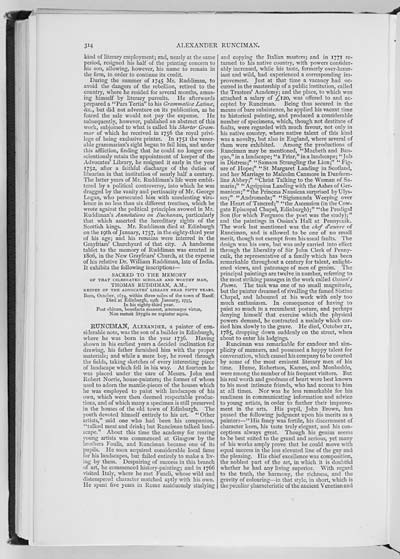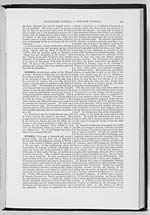314
kind of literary employment; and, nearly at the same
period, resigned his half of the printing concern to
his son, allowing, however, his name to remain in
the firm, in order to continue its credit.
During the summer of 1745 Mr. Ruddiman, to
avoid the dangers of the rebellion, retired to the
country, where he resided for several months, amus-
ing himself by literary pursuits. He afterwards
prepared a "Pars Tertia" to his Grammaticce Latina,
&c., but did not adventure on its publication, as he
feared the sale would not pay the expense. He
subsequently, however, published an abstract of this
work, subjoined to what is called his Shorter Gram-
mar of which he received in 1756 the royal privi-
lege of being exclusive printer. In 1751 the vener-
able grammarian's sight began to fail him, and under
this affliction, finding that he could no longer con-
scientiously retain the appointment of keeper of the
Advocates Library, he resigned it early in the year
1752, after a faithful discharge of the duties of
librarian in that institution of nearly half a century.
The latter years of Mr. Ruddiman's life were embit-
tered by a political controversy, into which he was
dragged by the vanity and pertinacity of Mr. George
Logan, who persecuted him with unrelenting viru-
lence in no less than six different treatises, which he
wrote against the political principles avowed in Mr.
Ruddiman's Annotations on Buchanan, particularly
that which asserted the hereditary rights of the
Scottish kings. Mr. Ruddiman died at Edinburgh
on the 19th of January, 1757, in the eighty-third year
of his age; and his remains were interred in the
Grayfriars' Churchyard of that city. A handsome
tablet to the memory of Ruddiman was erected in
1806, in the New Grayfriars' Church, at the expense
of his relative Dr. William Ruddiman, late of India.
It exhibits the following inscription:�
SACRED TO THE MEMORY
OF THAT CELEBRATED SCHOLAR AND WORTY MAN,
THOMAS RUDDIMAN, A.M.,
KEEPER OF THE ADVOCATES' LIBRARY NEAR FIFTY YEARS.
Born, October, 1674, within three miles of the town of Banff;
Died at Edinburgh, 19th January, 1757,
In his eighty-third year.
Post obitum, benefacta manent, seternaque virtus,
Non raetuit Stygiis ne rapiatur aquis.
BTJNCIMABT, ALEXANDER, a painter of con-
siderable note, was the son of a builder in Edinburgh,
where he was born in the year 1736. Having
shown in his earliest years a decided inclination for
drawing, his father furnished him with the proper
materials; and while a mere boy, he roved through
the fields, taking sketches of every interesting piece
of landscape which fell in his way. At fourteen he
was placed under the care of Messrs. John and
Robert Norrie, house-painters; the former of whom
used to adorn the mantle-pieces of the houses which
he was employed to paint with landscapes of his
own, which were then deemed respectable produc-
tions, and of which many a specimen is still preserved
in the houses of the old town of Edinburgh. The
youth devoted himself entirely to his art. " Other
artists," said one who had been his companion,
"talked meat and drink; but Runciman talked land-
scape." About this time the academy for rearing
young artists was commenced at Glasgow by the
brothers Foulis, and Runciman became one of its
pupils. He soon acquired considerable local fame
for his landscapes, but failed entirely to make a liv-
ing by them. Despairing of success in this branch
of art, he commenced history-painting; and in 1766
visited Italy, where he met Fuseli, whose wild and
distempered character matched aptly with his own.
He spent five years in Rome assiduously studying
and copying the Italian masters; and in 1771 re-
turned to his native country, with powers consider-
ably increased, while his taste, formerly over-luxur-
iant and wild, had experienced a corresponding im-
provement. Just at that time a vacancy had oc-
curred in the mastership of a public institution, called
the Trustees' Academy; and the place, to which was
attached a salary of �l2O, was offered to and ac-
cepted by Runciman. Being thus secured in the
means of bare subsistence, he applied his vacant time
to historical painting, and produced a considerable
number of specimens, which, though not destitute of
faults, were regarded with much favour, not only in
his native country, where native talent of this kind
was a novelty, but also in England, where several of
them were exhibited. Among the productions of
Runciman may be mentioned, "Macbeth and Ban-
quo," in a landscape; "a Friar," in a landscape; "Job
in Distress;" "Samson Strangling the Lion;" "Fig-
ure of Hope;" "St Margaret Landing in Scotland,
and her Marriage to Malcolm Canmore in Dunferm-
line Abbey;" "Christ Talking to the Woman of Sa-
maria;" " Agrippina Landing with the Ashes of Ger-
manicus;" "the Princess Nausicaa surprised by Ulys-
ses;" "Andromeda;" "Sigismunda Weeping over
the Heart of Tancred;" "the Ascension (in the Cow-
gate Episcopal Chapel, Edinburgh);" "the Prodigal
Son (for which Ferguson the poet was the study);"
and the paintings in Ossian's Hall at Pennycuik.
The work last mentioned was the chef cTceuvre of
Runciman, and is allowed to be one of no small
merit, though not exempt from his usual faults. The
design was his own, but was only carried into effect
through the liberality of Sir John Clerk of Penny-
cuik, the representative of a family which has been
remarkable throughout a century for talent, enlight-
ened views, and patronage of men of genius. The
principal paintings are twelve in number, referring to
the most striking passages in the work called Ossian's
Poems. The task was one of no small magnitude,
but the painter dreamed of rivalling the famed Sistine
Chapel, and laboured at his work with only too
much enthusiasm. In consequence of having to
paint so much in a recumbent posture, and perhaps
denying himself that exercise which the physical
powers demand, he contracted a malady which car-
ried him slowly to the grave. He died, October 21,
1785, dropping down suddenly on the street, when
about to enter his lodgings.
Runciman was remarkable for candour and sim-
plicity of manners, and possessed a happy talent for
conversation, which caused his company to be courted
by some of the most eminent literary men of his
time. Hume, Robertson, Kames, and Monboddo,
were among the number of his frequent visitors. But
his real worth and goodness of heart were best known
to his most intimate friends, who had access to him
at all times. Nor was he less remarkable for his
readiness in communicating information and advice
to young artists, in order to further their improve-
ment in the arts. His pupil, John Brown, has
passed the following judgment upon his merits as a
painter:�"His fancy was fertile, his discernment of
character keen, his taste truly elegant, and his con-
ceptions always great. Though his genius seems
to be best suited to the grand and serious, yet many
of his works amply prove that he could move with
equal success in the less elevated line of the gay and
the pleasing. His chief excellence was composition,
the noblest part of the art, in which it is doubtful
whether he had any living superior. With regard
to the truth, the harmony, the richness, and the
gravity of colouring�in that style, in short, which is
the peculiar characteristic of the ancient Venetian and

![]() Universal Viewer |
Universal Viewer | ![]() Mirador |
Large image | Transcription
Mirador |
Large image | Transcription
![]()

